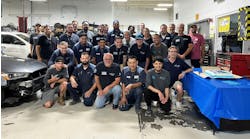Dealing with hazardous waste is difficult, but with the proper approach every shop can manage
With the complexities of operating a collision repair business, sometimes not all these questions may be addressed or acted upon. However, the costs of not properly and completely implementing the needed regulations could, in fact, be very great in an emergency situation or upon inspection.
Who regulates hazardous waste?
The hazardous waste regulations shops must meet vary, sometimes notably, from one community to another. There are federal laws for the nation. States and local communities can and often do have additional regulations that may apply to shops, depending on their locations. The department or regulating body overseeing these laws can itself vary. Regulations can fall under the jurisdiction of the state's department of environmental protection, the local fire department, local hazardous materials department or an air quality bureau. Obviously, this can create confusion.One of the most important tasks facing a shop is identifying both the laws that affect it and the body that oversees those laws. A good place to start is the state's department of environmental protection. Other potential sources of information are the local Better Business Bureau (BBB) or fire department.
You should also perform an Internet search to find hazardous waste compliance assistance programs. Local trade associations also can be good sources for the specific laws and regulations for your area. Though tracking down all potential regulators can be frustrating, it's important that a business does just this. Knowing who regulates an area's waste will help answer the next questions.
What is hazardous waste?
Any hazardous material that can no longer be used or recycled is considered hazardous waste.
Depending on where your shop is located, a long list of items may need to be treated as toxic waste. Waste thinners/reducers, solvent cleaners and excess refinish products are obvious examples of toxic waste. Other potential hazardous wastes can include spray booth filters and overspray dust.To identify potential items such as dry paint, filters and masking material, you should request a Toxicity Characteristic Leaching Procedure (TCLP) test be performed. A TCLP-licensed environmental laboratory will test samples of the materials in question. This test does not need to be repeated unless a shop uses new or different materials than those tested earlier. Test results will identify any toxins that must be included in the production amounts.
How much waste you generate each month determines how you will handle hazardous waste.
Based on the amount of waste they produce, shops fall into one of three waste generation categories:
- Conditionally-exempt generator — The shop generates up to 220 lbs. (100 kg) per month (220 lbs. fills a 55 gallon drum half way).
- Small-quantity generator — 220-2,200 lbs. per month (1.5 to 5-55 gallon drums).
- Large-quantity generator — Over 2,200 lbs. per month.
As its name implies, conditionally exempt means a shop is exempt from the more restrictive conditions regulating the other two (small and large) categories of generators. As a business generates larger amounts of waste, the regulations covering handling and storage become more restrictive. Businesses designated as small or large generators can store larger amounts, but their storage locations, along with other regulations, may have a significantly larger number of requirements to meet. What those specific restrictions or regulations may be depends on where in the country the business is located.
Regardless of what category a shop falls into, it's highly beneficial to reduce the amount of waste generated and therefore reduce the costs of complying with regulations.
How do I store hazardous waste?
Proper storage begins with complying with all fire, building and electrical codes. Your local fire department will need the location and inventory of flammable and toxic waste storage. These wastes need to be stored away from excess heat and sunlight and in a well-ventilated area. Materials stored in closed containers must be labeled correctly and include a spill tray or containment curb. Certain types of waste should not be mixed, such as solvent coatings with waterborne waste or coolant with solvent. You'll also want to look, again, at local on-site storage laws that can regulate container types, labeling and the handling of empty drums.Though storage can be a complex undertaking, training is available. I-CAR offers a "Hazardous Materials, Personal Safety, And Refinish Safety" program that provides training in such areas as:
- material safety data sheets (MSDS);
- labels;
- hazardous materials;
- personal protective equipment;
- repair facility safety; and
- hazardous wastes.
How do I dispose of hazardous waste?
Disposal of hazardous waste can be costly and complicated. Fortunately, shops can opt for several alternatives to help themselves. They can use a commercial treatment, storage, and disposal facility service; an on-site recycling or reuse system; or ship the waste to a recycling facility.
The simplest way is contracting a fully licensed and insured commercial hazardous waste company. These companies inspect shops, evaluate their needs and then set up a system that meets legal requirements, provides for necessary tracking and documentation, and sets up necessary storage equipment and proper labeling for the task.Shops also can choose an on-site solvent recycler. This option can reduce waste quantities significantly and provides reusable cleaning solvent. This threefold method of recycling, reducing and reusing will significantly reduce the cost of hazardous waste in a shop.
Recycling equipment that is designed specifically for collision shops is readily available. Even with the initial cost of equipment, recycling and reducing on-site reduces the overall cost of hazardous waste. Shops interested in the method should first check that their local communities allow for on-site recycling operations.Even with the use of recycling equipment, some waste still will be generated and need to be disposed of. Shops need to research a reputable licensed and insured waste hauler to transport their waste to a treatment or disposal center. Shops also need to know what type of disposal facility to send their waste to. Some facilities recycle liquid materials (which reduces the waste and leaving only a small amount for disposal). Others incinerate the waste; while others only dispose of the waste created in the state where they operate.
Regardless of which type of disposal facility a shop uses, operators need to realize that they remain responsible for that waste both while it is hauled to a disposal site and when it gets to a disposal location. If for any reason the waste is improperly handled, spilled or in any way becomes a danger to the public — by either the hauler or the disposal company — the initial generator is considered liable. Because of this obligation, shops need to carefully evaluate the companies that handle their hazardous waste.
A search of the Web can help generate licensed and approved waste haulers and disposal companies for your area. Shops always should take the additional step of further investigating to verify their reputations.Conclusion
The proper handling of collision repair shop-generated hazardous waste can be complex. With careful research, patience and the proper training, every shop can comply with the required regulations and provide a safe workplace.



